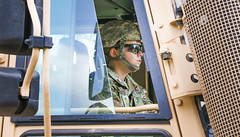Friday, October 6, 2006
The acrid haze situation in Southeast Asia is worsening. Visibility has been severely reduced in neighboring countries and some schools have been closed due to the health hazard posed. The annual smoke season is caused by illegal slash and burn clearance of land in Indonesia, particularly the island of Borneo.
The haze has spread over 2,250 miles (3,600 kilometers) into neighboring countries such as Singapore, Malaysia, Thailand, and even drifting to Guam in the western Pacific.
Aviation has been severely impaired in Indonesia, where in certain areas, visibility is only a mere 200 to 300 meters. Helicopter service in Malaysia’s Sarawak state, a key mode of transportation there, has been halted due to the poor visibility. A Mandala Airlines Boeing 737-200 carrying a 110 people had overshot the runway at Tarakan airport in Kalimantan province in Indonesia. The aircraft came partly to rest in a nearby swamp. Visibility at the time was around 400 meters, 600 meters short of Indonesian landing safety regulations.
Schools in Thailand, and Indonesia have also been forced to closed, and look likely to stay closed well into next week.
Air pollution indices around the region have also registered a spike in poor air quality. Sarawak state’s index came in at 106-188 with 100-200 being unhealthy. In Malay peninsula, the air pollution index in five states came in at 101-116. In Singapore, the Pollution Standards Index registered between 80-130 with 81-100 in the moderate range and 101-200 in the unhealthy range.
Wikinews journalist Timlee90 reports:
The air quality here in Singapore is so bad that I could feel the dust in my mouth as I was walking on the streets today. The air constantly smells of burning wood and visibility is never more than a kilometer. Singaporeans I know are concerned about the deteriorating situation.
Timothy Low, a Singaporean who’s just finished his national service says that he is concerned about the situation, “I can’t run to exercise. People with lung related problems have difficulty breathing; It causes tearing also.” The government here has advised citizens to reduce vigorous activity, especially those with existing heart or lung conditions.
The Indonesian government has been criticized by environmentalist groups such as Greenpeace, which claims that the allowed conversion of forests into cropland is the cause of the problem. The also call on the Indonesian government to “investigate and hold liable plantation companies responsible for slash and burn clearing”.
The Indonesian government has responded to the criticism that it is doing all that it can do. “We don’t know when we can put out the fires but we are working tirelessly and have spent billions of rupiah (hundreds of thousands of dollars) in our efforts,” Forestry Minister Malem Sambat Kaban said. “As for complaints from neighbouring countries, there’s nothing else we can do. We don’t cause the fires deliberately.”
In 1997-98, the haze cost the Southeast Asian region an estimated US$9.0 billion by disrupting air travel and other business activities


